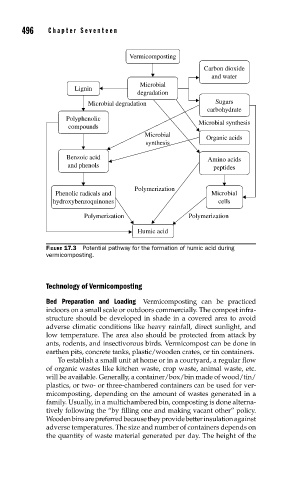Page 524 - Biosystems Engineering
P. 524
496 Cha pte r Se v e ntee n
Vermicomposting
Carbon dioxide
and water
Microbial
Lignin
degradation
Microbial degradation Sugars
carbohydrate
Polyphenolic
Microbial synthesis
compounds
Microbial
Organic acids
synthesis
Benzoic acid Amino acids
and phenols peptides
Polymerization
Phenolic radicals and Microbial
hydroxybenzoquinones cells
Polymerization Polymerization
Humic acid
FIGURE 17.3 Potential pathway for the formation of humic acid during
vermicomposting.
Technology of Vermicomposting
Bed Preparation and Loading Vermicomposting can be practiced
indoors on a small scale or outdoors commercially. The compost infra-
structure should be developed in shade in a covered area to avoid
adverse climatic conditions like heavy rainfall, direct sunlight, and
low temperature. The area also should be protected from attack by
ants, rodents, and insectivorous birds. Vermicompost can be done in
earthen pits, concrete tanks, plastic/wooden crates, or tin containers.
To establish a small unit at home or in a courtyard, a regular flow
of organic wastes like kitchen waste, crop waste, animal waste, etc.
will be available. Generally, a container/box/bin made of wood/tin/
plastics, or two- or three-chambered containers can be used for ver-
micomposting, depending on the amount of wastes generated in a
family. Usually, in a multichambered bin, composting is done alterna-
tively following the “by filling one and making vacant other” policy.
Wooden bins are preferred because they provide better insulation against
adverse temperatures. The size and number of containers depends on
the quantity of waste material generated per day. The height of the

